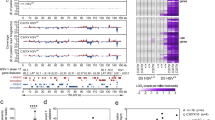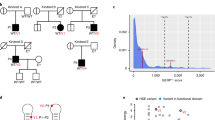Abstract
Herpes simplex encephalitis (HSE) in children has previously been linked to defects in type I interferon production downstream of Toll-like receptor (TLR)3. In the present study, we used whole-exome sequencing to investigate the genetic profile of 16 adult patients with a history of HSE. We identified novel mutations in IRF3, TYK2 and MAVS, molecules involved in generating innate antiviral immune responses, which have not previously been associated with HSE. Moreover, data revealed mutations in TLR3, TRIF, TBK1 and STAT1 known to be associated with HSE in children but not previously described in adults. All discovered mutations were heterozygous missense mutations, the majority of which were associated with significantly decreased antiviral responses to HSV-1 infection and/or the TLR3 agonist poly(I:C) in patient peripheral blood mononuclear cells compared with controls. Altogether, this study demonstrates novel mutations in the TLR3 signaling pathway in molecules previously identified in children, suggesting that impaired innate immunity to HSV-1 may also increase susceptibility to HSE in adults. Importantly, the identification of mutations in innate signaling molecules not directly involved in TLR3 signaling suggests the existence of innate immunodeficiencies predisposing to HSE beyond the TLR3 pathway.
This is a preview of subscription content, access via your institution
Access options
Subscribe to this journal
Receive 6 digital issues and online access to articles
$119.00 per year
only $19.83 per issue
Buy this article
- Purchase on Springer Link
- Instant access to full article PDF
Prices may be subject to local taxes which are calculated during checkout









Similar content being viewed by others
References
Griffin DE . Encephalitis, myelitis, and neuritis In: Mandell GL, Bennett JE, Dolin R (eds). Principles and Practice in Infectious Diseases. Elsevier: Philadelphia, 2005 pp: 1143–1150.
Zhang SY, Jouanguy E, Ugolini S, Smahi A, Elain G, Romero P et al. TLR3 deficiency in patients with herpes simplex encephalitis. Science 2007; 317: 1522–1527.
Roizman B, Knipe DM, Whitley RJ . Herpes simplex viruses. In: Knipe DM, Howley PM (eds). Fields Virology. Lippincott Williams & Wilkins: Philadelphia, 2007 pp: 2501–2602.
Paludan SR, Bowie AG, Horan KA, Fitzgerald KA . Recognition of herpesviruses by the innate immune system. Nat Rev Immunol 2011; 11: 143–154.
Liu T, Khanna KM, Chen X, Fink DJ, Hendricks RL . CD8(+) T cells can block herpes simplex virus type 1 (HSV-1) reactivation from latency in sensory neurons. J Exp Med 2000; 191: 1459–1466.
Biron CA, Byron KS, Sullivan JL . Severe herpesvirus infections in an adolescent without natural killer cells. N Engl J Med 1989; 320: 1731–1735.
Kurt-Jones EA, Chan M, Zhou S, Wang J, Reed G, Bronson R et al. Herpes simplex virus 1 interaction with Toll-like receptor 2 contributes to lethal encephalitis. Proc Natl Acad Sci USA 2004; 101: 1315–1320.
Lund J, Sato A, Akira S, Medzhitov R, Iwasaki A . Toll-like receptor 9-mediated recognition of Herpes simplex virus-2 by plasmacytoid dendritic cells. J Exp Med 2003; 198: 513–520.
Krug A, Luker GD, Barchet W, Leib DA, Akira S, Colonna M . Herpes simplex virus type 1 activates murine natural interferon-producing cells through toll-like receptor 9. Blood 2004; 103: 1433–1437.
Rasmussen SB, Sorensen LN, Malmgaard L, Ank N, Baines JD, Chen ZJ et al. Type I interferon production during herpes simplex virus infection is controlled by cell-type-specific viral recognition through Toll-like receptor 9, the mitochondrial antiviral signaling protein pathway, and novel recognition systems. J Virol 2007; 81: 13315–13324.
Sorensen LN, Reinert LS, Malmgaard L, Bartholdy C, Thomsen AR, Paludan SR . TLR2 and TLR9 synergistically control herpes simplex virus infection in the brain. J Immunol 2008; 181: 8604–8612.
Unterholzner L, Keating SE, Baran M, Horan KA, Jensen SB, Sharma S et al. IFI16 is an innate immune sensor for intracellular DNA. Nat Immunol 2010; 11: 997–1004.
Li XD, Wu J, Gao D, Wang H, Sun L, Chen ZJ . Pivotal roles of cGAS-cGAMP signaling in antiviral defense and immune adjuvant effects. Science 2013; 341: 1390–1394.
Weber F, Wagner V, Rasmussen SB, Hartmann R, Paludan SR . Double-stranded RNA is produced by positive-strand RNA viruses and DNA viruses but not in detectable amounts by negative-strand RNA viruses. J Virol 2006; 80: 5059–5064.
Chiu YH, Macmillan JB, Chen ZJ . RNA polymerase III detects cytosolic DNA and induces type I interferons through the RIG-I pathway. Cell 2009; 138: 576–591.
Melchjorsen J, Rintahaka J, Soby S, Horan KA, Poltajainen A, Ostergaard L et al. Early innate recognition of herpes simplex virus in human primary macrophages is mediated via the MDA5/MAVS-dependent and MDA5/MAVS/RNA polymerase III-independent pathways. J Virol 2010; 84: 11350–11358.
Casrouge A, Zhang SY, Eidenschenk C, Jouanguy E, Puel A, Yang K et al. Herpes simplex virus encephalitis in human UNC-93B deficiency. Science 2006; 314: 308–312.
Kim YM, Brinkmann MM, Paquet ME, Ploegh HL . UNC93B1 delivers nucleotide-sensing toll-like receptors to endolysosomes. Nature 2008; 452: 234–238.
Guo Y, Audry M, Ciancanelli M, Alsina L, Azevedo J, Herman M et al. Herpes simplex virus encephalitis in a patient with complete TLR3 deficiency: TLR3 is otherwise redundant in protective immunity. J Exp Med 2011; 208: 2083–2098.
Sancho-Shimizu V, Perez de DR, Lorenzo L, Halwani R, Alangari A, Israelsson E et al. Herpes simplex encephalitis in children with autosomal recessive and dominant TRIF deficiency. J Clin Invest 2011; 121: 4889–4902.
Perez de DR, Sancho-Shimizu V, Lorenzo L, Puel A, Plancoulaine S, Picard C et al. Human TRAF3 adaptor molecule deficiency leads to impaired Toll-like receptor 3 response and susceptibility to herpes simplex encephalitis. Immunity 2010; 33: 400–411.
Herman M, Ciancanelli M, Ou YH, Lorenzo L, Klaudel-Dreszler M, Pauwels E et al. Heterozygous TBK1 mutations impair TLR3 immunity and underlie herpes simplex encephalitis of childhood. J Exp Med 2012; 209: 1567–1582.
Audry M, Ciancanelli M, Yang K, Cobat A, Chang HH, Sancho-Shimizu V et al. NEMO is a key component of NF-kappaB- and IRF-3-dependent TLR3-mediated immunity to herpes simplex virus. J Allergy Clin Immunol 2011; 128: 610–617.
Casanova JL, Abel L . Primary immunodeficiencies: a field in its infancy. Science 2007; 317: 617–619.
Andersen LL, Mørk N, Reinert LS, Kofod-Olsen E, Narita R, Jørgensen SE et al. Inherited autosomal dominant IRF3 deficiency in a patient with herpes simplex encephalitis. J Exp Med 2015; 212: 1371–1379.
Liu S, Cai X, Wu J, Cong Q, Chen X, Li T et al. Phosphorylation of innate immune adaptor proteins MAVS, STING, and TRIF induces IRF3 activation. Science 2015; 347: aaa2630.
Velazquez L, Fellous M, Stark GR, Pellegrini S . A protein tyrosine kinase in the interferon alpha/beta signaling pathway. Cell 1992; 70: 313–322.
Minegishi Y, Saito M, Morio T, Watanabe K, Agematsu K, Tsuchiya S et al. Human tyrosine kinase 2 deficiency reveals its requisite roles in multiple cytokine signals involved in innate and acquired immunity. Immunity 2006; 25: 745–755.
Kilic SS, Hacimustafaoglu M, Boisson-Dupuis S, Kreins AY, Grant AV, Abel L et al. A patient with tyrosine kinase 2 deficiency without hyper-IgE syndrome. J Pediatr 2012; 160: 1055–1057.
Kreins AY, Ciancanelli MJ, Okada S, Kong XF, Ramirez-Alejo N, Kilic SS et al. Human TYK2 deficiency: Mycobacterial and viral infections without hyper-IgE syndrome. J Exp Med 2015; 212: 1641–1662.
Mogensen TH . Pathogen recognition and inflammatory signaling in innate immune defenses. Clin Microbiol Rev 2009; 22: 240–273.
Kumar H, Kawai T, Kato H, Sato S, Takahashi K, Coban C et al. Essential role of IPS-1 in innate immune responses against RNA viruses. J Exp Med 2006; 203: 1795–1803.
Xu LG, Wang YY, Han KJ, Li LY, Zhai Z, Shu HB . VISA is an adapter protein required for virus-triggered IFN-beta signaling. Mol Cell 2005; 19: 727–740.
Lafaille FG, Pessach IM, Zhang SY, Ciancanelli MJ, Herman M, Abhyankar A et al. Impaired intrinsic immunity to HSV-1 in human iPSC-derived TLR3-deficient CNS cells. Nature 2012; 491: 769–773.
Casanova JL, Conley ME, Seligman SJ, Abel L, Notarangelo LD . Guidelines for genetic studies in single patients: lessons from primary immunodeficiencies. J Exp Med 2014; 211: 2137–2149.
Dupuis S, Jouanguy E, Al-Hajjar S, Fieschi C, Al-Mohsen IZ, Al-Jumaah S et al. Impaired response to interferon-alpha/beta and lethal viral disease in human STAT1 deficiency. Nat Genet 2003; 33: 388–391.
Uzel G, Sampaio EP, Lawrence MG, Hsu AP, Hackett M, Dorsey MJ et al. Dominant gain-of-function STAT1 mutations in FOXP3 wild-type immune dysregulation-polyendocrinopathy-enteropathy-X-linked-like syndrome. J Allergy Clin Immunol 2013; 131: 1611–1623.
van de Veerdonk FL, Plantinga TS, Hoischen A, Smeekens SP, Joosten LA, Gilissen C et al. STAT1 mutations in autosomal dominant chronic mucocutaneous candidiasis. N Engl J Med 2011; 365: 54–61.
Carty M, Reinert L, Paludan SR, Bowie AG . Innate antiviral signalling in the central nervous system. Trends Immunol 2014; 35: 79–87.
Abel L, Plancoulaine S, Jouanguy E, Zhang SY, Mahfoufi N, Nicolas N et al. Age-dependent Mendelian predisposition to herpes simplex virus type 1 encephalitis in childhood. J Pediatr 2010; 157: 623–629, 629.e1.
Lim HK, Seppanen M, Hautala T, Ciancanelli MJ, Itan Y, Lafaille FG et al. TLR3 deficiency in herpes simplex encephalitis: High allelic heterogeneity and recurrence risk. Neurology 2014; 83: 1888–1897.
Yordy B, Iwasaki A . Cell type-dependent requirement of autophagy in HSV-1 antiviral defense. Autophagy 2013; 9: 236–238.
Piirila H, Valiaho J, Vihinen M . Immunodeficiency mutation databases (IDbases). Hum Mutat 2006; 27: 1200–1208.
Kanehisa M, Goto S . KEGG: kyoto encyclopedia of genes and genomes. Nucleic Acids Res 2000; 28: 27–30.
Kanehisa M, Goto S, Sato Y, Kawashima M, Furumichi M, Tanabe M . Data, information, knowledge and principle: back to metabolism in KEGG. Nucleic Acids Res 2014; 42: D199–D205.
Kircher M, Witten DM, Jain P, O'Roak BJ, Cooper GM, Shendure J . A general framework for estimating the relative pathogenicity of human genetic variants. Nat Genet 2014; 46: 310–315.
Acknowledgements
NM was supported by a grant from the Lundbeck Foundation (# R144-2013-13436). EKO, LØ and THM received financial support from RegionMidt related to ICID. THM and SRP were funded by a grant from the Danish Research Council (# 11-107588, 12-124330). In addition, the work was supported by Kong Christian IX, Aase og Ejnar Danielsens Fond, Dronning Louises Jubilæumslegat and The Foundation for the Advancement of Medical Sciences.
Author information
Authors and Affiliations
Corresponding author
Ethics declarations
Competing interests
The authors declare no conflict of interest.
Additional information
Supplementary Information accompanies this paper on Genes and Immunity website
Supplementary information
Rights and permissions
About this article
Cite this article
Mørk, N., Kofod-Olsen, E., Sørensen, K. et al. Mutations in the TLR3 signaling pathway and beyond in adult patients with herpes simplex encephalitis. Genes Immun 16, 552–566 (2015). https://doi.org/10.1038/gene.2015.46
Received:
Revised:
Accepted:
Published:
Issue Date:
DOI: https://doi.org/10.1038/gene.2015.46
This article is cited by
-
Infection and inflammation: radiological insights into patterns of pediatric immune-mediated CNS injury
Neuroradiology (2023)
-
Prevalence of Pathogenic and Potentially Pathogenic Inborn Error of Immunity Associated Variants in Children with Severe Sepsis
Journal of Clinical Immunology (2022)
-
Nuclear ADP-ribosylation drives IFNγ-dependent STAT1α enhancer formation in macrophages
Nature Communications (2021)
-
Host genetic susceptibility to viral infections: the role of type I interferon induction
Genes & Immunity (2020)
-
Herpes simplex virus encephalitis of childhood: inborn errors of central nervous system cell-intrinsic immunity
Human Genetics (2020)



